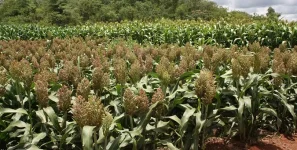Optimism surrounds Zimbabwe after agricultural assessments demonstrate expanded cultivation of critical food crops across farming regions. The new data points to expanded acreage of maize and traditional grains during the 2024/2025 summer growing season. These increases slightly exceed planned targets established to enhance food security and build national grain reserves. Agriculture business advisers gathered this information as part of the First Round of Crops, Livestock, and Fisheries Assessment report released recently.
These advisers collected data throughout 1,600 wards nationwide, providing essential insights for government planning. Their assessment captures current agricultural conditions, including detailed information about crop production status, animal health metrics, fish farming operations, and total planted areas. Officials thoroughly reviewed and verified all collected information between February 1 and 8 before presenting findings to Cabinet members.
Statistics show maize cultivation expanded 5.4 percent from 1,728,897 hectares last season to 1,822,904 hectares during current plantings. This figure marginally exceeds the target of 1,800,000 hectares set by agricultural authorities. Traditional grains experienced even stronger growth, with a 7 percent increase to 434,374 hectares from previous levels of 405,116 hectares, surpassing expectations by 4 percent above targeted amounts.
These increases represent positive developments for Zimbabwean food security since these crops serve as dietary staples for most citizens. Improved rainfall patterns during late 2024 and early 2025 contributed to favorable growing conditions for maize when assessments occurred. The horticulture sector faced challenges due to El Niño drought conditions that limited irrigation water availability during crucial growing periods.
Certain fruit crops showed modest gains, with increased areas dedicated to blueberry, orange, and coffee production across farming regions. Tea cultivation decreased because of low market prices combined with rising production costs for growers. Overall, horticultural planted areas barely increased from 11,952 hectares last season to 11,957 hectares during current plantings, according to official assessment data.
Livestock production demonstrated resilience despite severe drought conditions affecting many areas. The national beef cattle population grew slightly by 0.4 percent from 5,718,523 animals in 2023 to 5,741,397 in 2024, according to current figures. Dairy herds showed stronger expansion, with an 8.7 percent increase from 60,398 cattle to 65,659 animals during the same period across Zimbabwe.
These improvements generated substantial increases in dairy production, with raw milk output rising 15 percent to 11,699,440 liters compared to the previous production of 99,823,775 liters recorded in 2023. The assessment represents collaborative efforts between the Zimbabwe National Statistics Agency and the Ministry of Lands, Agriculture, Fisheries, Water, and Rural Development to monitor agricultural productivity.
These advisers collected data throughout 1,600 wards nationwide, providing essential insights for government planning. Their assessment captures current agricultural conditions, including detailed information about crop production status, animal health metrics, fish farming operations, and total planted areas. Officials thoroughly reviewed and verified all collected information between February 1 and 8 before presenting findings to Cabinet members.
Statistics show maize cultivation expanded 5.4 percent from 1,728,897 hectares last season to 1,822,904 hectares during current plantings. This figure marginally exceeds the target of 1,800,000 hectares set by agricultural authorities. Traditional grains experienced even stronger growth, with a 7 percent increase to 434,374 hectares from previous levels of 405,116 hectares, surpassing expectations by 4 percent above targeted amounts.
These increases represent positive developments for Zimbabwean food security since these crops serve as dietary staples for most citizens. Improved rainfall patterns during late 2024 and early 2025 contributed to favorable growing conditions for maize when assessments occurred. The horticulture sector faced challenges due to El Niño drought conditions that limited irrigation water availability during crucial growing periods.
Certain fruit crops showed modest gains, with increased areas dedicated to blueberry, orange, and coffee production across farming regions. Tea cultivation decreased because of low market prices combined with rising production costs for growers. Overall, horticultural planted areas barely increased from 11,952 hectares last season to 11,957 hectares during current plantings, according to official assessment data.
Livestock production demonstrated resilience despite severe drought conditions affecting many areas. The national beef cattle population grew slightly by 0.4 percent from 5,718,523 animals in 2023 to 5,741,397 in 2024, according to current figures. Dairy herds showed stronger expansion, with an 8.7 percent increase from 60,398 cattle to 65,659 animals during the same period across Zimbabwe.
These improvements generated substantial increases in dairy production, with raw milk output rising 15 percent to 11,699,440 liters compared to the previous production of 99,823,775 liters recorded in 2023. The assessment represents collaborative efforts between the Zimbabwe National Statistics Agency and the Ministry of Lands, Agriculture, Fisheries, Water, and Rural Development to monitor agricultural productivity.












